![]()
![]()
![]()
Use LEFT and RIGHT arrow keys to navigate between flashcards;
Use UP and DOWN arrow keys to flip the card;
H to show hint;
A reads text to speech;
13 Cards in this Set
- Front
- Back
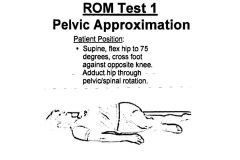
ROM 1: Pelvic Approximation
|

ROM 1
• Make sure they are not pushing or bracing their knee with the foot for more range. Motion comes from only the trunk. • Shoulders should stay on the table. • Check if adductor's are cramping, if they are limited and cramping it probably an issue. • This ROM is what a lot of people do for a “back stretch” and is not good for the lumbar spine if stretched in this position. |
|
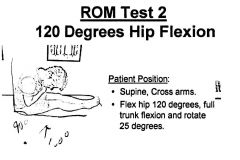
ROM 2: 120º Hip Flexion
|

ROM 2
• Sit on ischial tuberosity(s) • Flexion between femur and hip • Rotate trunk 25º and then flex trunk. |
|
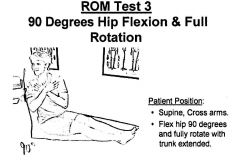
ROM 3: 90º Hip Flexion & Full Rotation
|

ROM 3
• Trunk extended (sit tall) at 90º • Look at which side has more rotation |
|
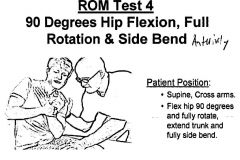
ROM 4: 90º Hip Flexion, Full Rotation & Side Bend (Anteriorly)
|

ROM 4
• Sidebend anteriorly • Treating the things that can rotate you to the right and sidebend you to the left. • Keep trunk extended as you sidebend. • If you rotate to right, side bend to left. • If you rotate to the left, side bend to the right. |
|
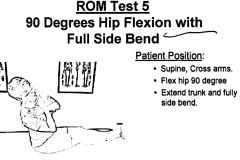
ROM 5: 90º Hip Flexion with Full Side Bend
|

ROM 5
• Sidebend with no rotation. • Neutral sidebend • If they can’t extend the legs while keeping 90º hip flexion, slightly move legs off table until they can (microprogression to neutral position in time). • Make “L” at ribs to show where they need to sidebend over. • Could mean tight hamstrings. |
|

ROM 6: Full Hip Flexion, Full Rotation & Full Sidebend
|
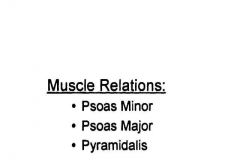
ROM 6
• Sidebend anteriorly • Looking more at hip flexion. • Extend spine some, rotate to the right and side bend anteriorly to the left & vice versa for opposite side. • Monitor sacrum. • If you rotate to the left and side bend to the right: You will muscle test the right side (side that is shortening). |
|
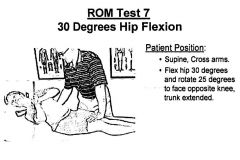
ROM 7: 30º Hip Flexion:
|

ROM 7
• Start them at 90º hip flexion, drop them back to 30º, extend spine and rotate 25º (to left and right). • Inversion of action: Hip Flexion • Place forearm across legs to brace them. • As you bring them back to 30º flexion, place a hand under their back, hold them as much as you have to (microprogression to pos.) or consider it weakness possibilities if it just hurts. |
|
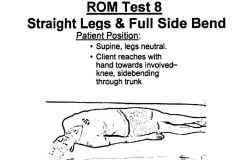
ROM 8: Straight Legs and Full Side Bend:
|

ROM 8
• Make sure they go back to neutral and pause before they side-bend to the opposite side. • Reach hand towards knee so they sidebend and don’t move neck. • Make sure the hips aren’t compensating • Shoulders and hips must stay against table. |
|

ROM 9: Straight Legs and Full Side Bend With Hip Internal Rotation
|
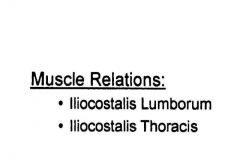
ROM 9
• Same as before but sidebend while holding internal rotation. • Side bending to side that you are internally rotating in. • You can grab their tibia after they internally/externally rotate. |
|

ROM 10: Straight Legs and Full Sidebend with Hip External Rotation
|
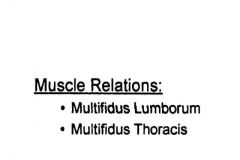
ROM 10
• Same thing as before but this time external rotation. • Sidebend to the side you are externally rotating. |
|
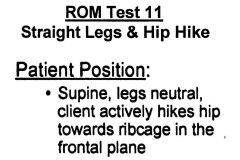
ROM 11: Straight Legs and Hip Hike
|

ROM 11
• THE PICTURE IN THE MANUAL IS WRONG ON THIS ROM. • Instead of bringing trunk to hip, bring hip to your trunk. • Inverse action: sidebend • Hike the hip in the frontal plane toward the rib cage of the same side. |
|
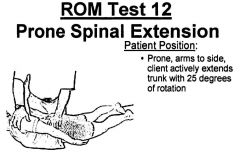
ROM 12: Prone Spinal Extension
|

ROM 12
• Don’t tell them anything about their legs, observe what happens. • Vision a “pole” through their head, and they are rotating to each side through that “pole”. • After they rotate to one side, have them re-do the test and repeat to the other side. • ALWAYS: “Re-set” them, so they do not lose extension. |
|
|
Trunk/Spine ROM:
|
• All trunk ROM Exams are active
• Try to keep neutral cervical spine (Especially side-bend). • Closely pay attention to all movements throughout the active ROM’s, people do little things to compensate (like cervical rotation). • Always “re-set” them during each test before they rotate to the opposite side. • DON’T FORGET: Straight leg: internal and external rotation (LowerBody ROM Exams that correlate to TVA). |

